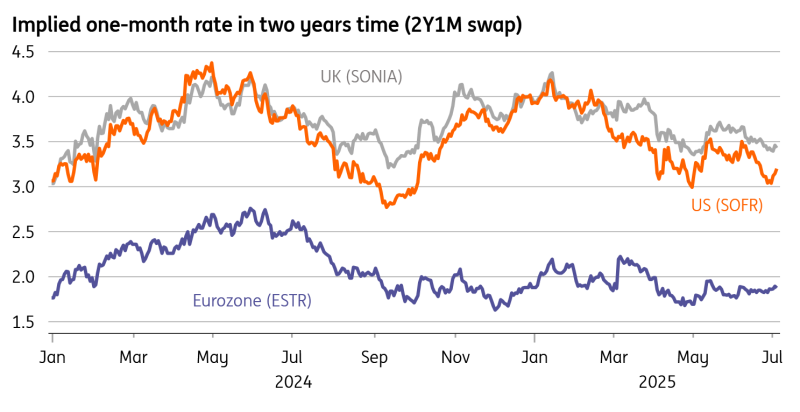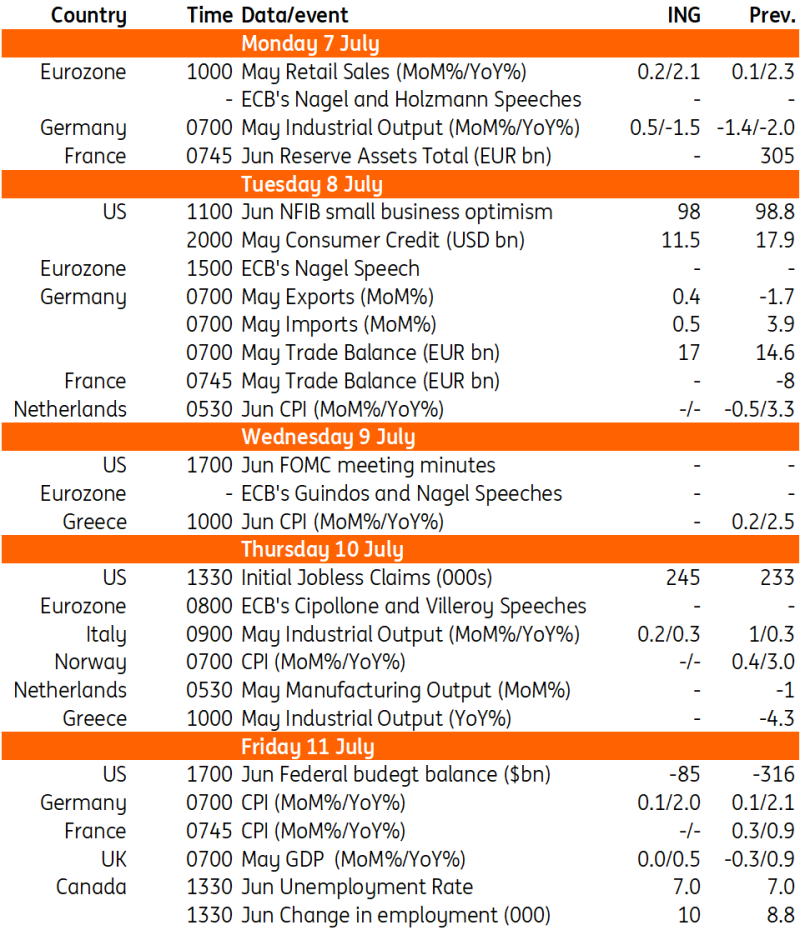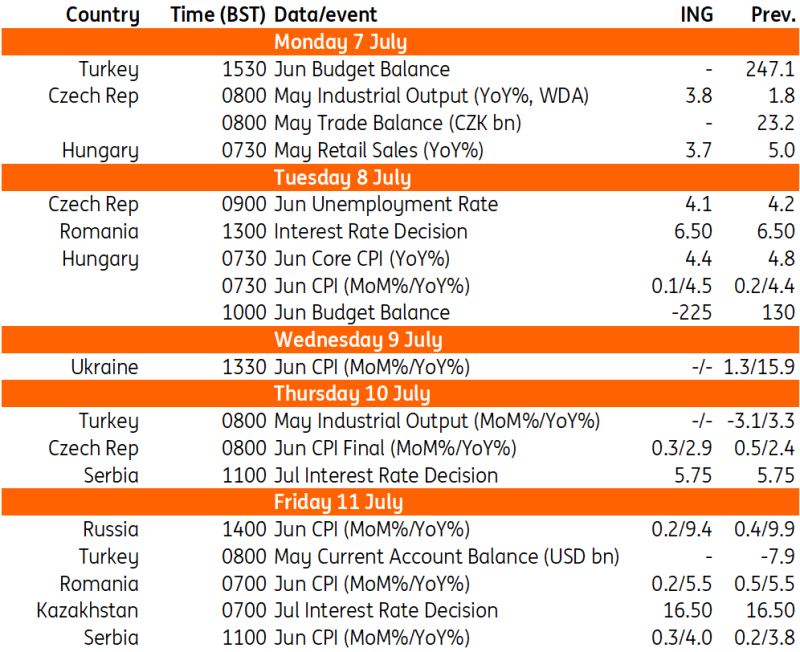US President Donald Trump’s 90-day trade reprieve is ending. Tariff noise is back, but does it really matter? US has stayed surprisingly benign and the economy is holding up, despite the rollercoaster so far. But expect that to change, writes James Smith, as he and the team tackle another big week in the world of macro and markets
Do Tariffs Matter Anymore?
We end the week with President Trump threatening to unilaterally ramp up tariffs on a swathe of major trading partners, which he says could range from 10% to 70%. Vietnam – a country with one of the most sizeable trade surpluses with the US – has already seen its tariffs doubled. You’d be forgiven for thinking this is all a bit ‘Liberation Day 2.0’.
Investors have, of course, seen this show before. It’s not the first time that the US administration has upped the ante days before a deadline – just think of the EU and the threat of a 50% tariff just a few weeks ago.
It’s not that markets are completely immune to tariff noise altogether, and my colleague Chris Turner writes that is priced for more volatility over the next three weeks. I’ve felt for a while that the current level of tariffs – around 14% if averaged out across everything the US imports – probably represents a floor rather than a ceiling.
But if I had to guess, most investors are probably expecting next week’s end to the 90-day delay to April’s reciprocal tariffs to come and go without any major drama. That’s our view too.
Whisper it, but things actually don’t look too bad from the perspective of the US administration right now. The – perceived to be a key bellwether within the White House – is at all-time highs (though best not to mention the dollar). The economy has largely held up, abstracting from import-related noise in the figures. And inflation so far hasn’t taken off in any meaningful way.
All the while, the US is collecting huge sums of tariff revenue – something that will have indirectly helped the passage of Trump’s tax bill. And so long as talks continue, trading partners like the EU have been reticent to retaliate in full.
Here’s the question, though: has the economic impact of tariffs genuinely been less bad than just about everyone feared earlier this year? Or is everything just happening with more of a lag?
When it comes to inflation at least, James Knightley firmly thinks it’s the latter. The Fed’s preferred inflation gauge, the deflator, has been surprisingly benign for three months now. But when we get June’s data later this month, James K thinks that will change – and even more so when we get the numbers for July and August.
We know from tariffs in Trump’s first term that it took a good three months or so for the effects to show up fully in prices. And this time around, American companies saw the tariffs coming and filled every ounce of warehouse space with stock. That inventory buffer has potentially offered companies, particularly those lacking pricing power, a window to ‘wait and see’ before lifting prices. But that window won’t last forever.
The potential for a summer of hot inflation is the principal reason why we’re not expecting a September rate cut from the Fed, despite it being near-enough priced into financial markets. We’re looking for a November, or more likely December restart on Fed easing.
As for the economy generally, the jury’s out on whether we’re still waiting on the worst of the tariff hit. The delay in China’s tariff levels probably came just in time to avert a more serious recessionary threat. The latest certainly doesn’t point to the bottom falling out of the labour market, though if we’re talking about time lags, this is usually the last place economic damage shows up. Sentiment remains fragile, remember. Tariffs have taken the wind out of the sails of the US economy.
That points to more muted growth rates from now on and that’s particularly problematic for America’s perilous public finances. My colleagues think that The One Big Beautiful Bill Act, passed this week, if anything, looks like an economic headwind. They write that the bond markets may be getting too complacent, given the potent combination of higher inflation and a wave of debt issuance later this summer.
Here in Europe, the threat of tariffs is manifesting itself in an unexpected opponent for the European Central Bank: a stronger and more volatile euro. A drumbeat of comments from ECB officials this week suggests that EUR/USD at 1.20 (a level that investors were flirting with before Thursday’s hawkish US jobs numbers) might represent an informal line in the sand.
Frankfurt was already getting more nervous about the downside risks to inflation back at the June meeting, as this week’s minutes demonstrated. Carsten reckons a stronger euro only solidifies a September . An unexpected increase in US tariffs on the EU next week would only build that case further.
Chart of the Week: Markets Priced Out Rate Cuts After Solid Jobs Numbers

Source: Macrobond, ING
THINK Ahead in Developed Markets
United States
- Jobs Steady, Fed Cautious: In what is a very quiet week for US data, the highlight will be the release of the June , along with commentary from the handful of Fed speakers scheduled. The latest jobs report has suggested the labour market continues to hold up despite concerns about a cooling economy, while officials remain nervous about the effect of tariff-induced price hikes on inflation.
- Given this backdrop, a July Federal Reserve interest rate cut looks highly unlikely. In terms of numbers, we will be watching the fiscal deficit data, which is tracking towards the US government borrowing around $2tr this year.
Eurozone
- Retail sales (Mon): across the eurozone are expected to have marginally improved again in May. This would continue a cautious recovery after stalling in the latter part of 2024. Despite a backdrop of strong wage growth, which has outpaced inflation in many member states, consumer spending still suffers from low confidence, likely due to high price levels and large geopolitical and economic uncertainty.
United Kingdom
- May GDP (Fri): Expect another lacklustre set of figures, following a remarkably strong first quarter. The first few months of the year were, to some extent anyway, helped by tariff frontloading. But it’s also a repeat of what we’ve seen the past few years, where the first few months of the year have been much stronger than the remaining months. This looks like a statistical phenomenon and suggests that we should take the recent volatility in GDP with a pinch of salt.
Canada
- Labour Data (Fri): The Canadian jobs data is expected to show holding at 7% with little change in employment. The central concern for Canada’s economy remains the state of US-Canadian trade and the lack of progress on a deal is unsettling with the Bank of Canada likely to cut interest rates again in the autumn.
THINK Ahead in Central and Eastern Europe
Hungary
- Inflation (Tue): Next week’s macro calendar will be front-loaded in Hungary, and in our view, the most interesting release will be the June inflation figure. Despite the various price shield measures in place, we expect year-on-year inflation to remain high. While the monthly repricing will be relatively muted (0.1% for both headline and core inflation), this will provide little structural relief.
- The June data will not be a game changer for the National Bank of Hungary, particularly since the central bank’s forecast is in line with our own predictions for June. However, even if the data showed an improvement in inflation, we would still predict no change in rates this year due to high and sticky inflation expectations.
Czech Republic
- Growth and Unemployment (Fri): Annual growth in industrial production gained pace in May when adjusted for the number of working days. Czech industry appears to be bottoming out; however, it remains to be seen whether this will lead to a more substantial rebound or another false dawn. The unemployment rate is likely to have continued softening in June, as the construction and tourism sectors were shown to be in full swing. Inflation for June is expected to be confirmed at the preliminary estimates.
Kazakhstan
- Base Rate Decision (Fri): We anticipate that the National Bank of Kazakhstan (NBK) will maintain the base rate at 16.50%. There still may be a need for an additional hike later this year, particularly if inflation continues to accelerate from the recent high of 11.8% year-on-year in June, challenging the newly revised year-end NBK forecast of 12.5% YoY. But for now, we believe the NBK will adopt a wait-and-see approach to determine if the recent tightening of the macroprudential framework effectively addresses demand-driven price pressures by cooling loan growth, which currently stands at 23% YoY in the retail segment. Additionally, the fiscal situation, particularly spending from the sovereign fund (NFRK), which is currently at 4.1% of GDP on a 12-month rolling basis, will be closely monitored.
Key Events in Developed Markets Next Week

Source: Refinitiv, ING
Key Events in EMEA Next Week

Source: Refinitiv, ING
Disclaimer: This publication has been prepared by ING solely for information purposes irrespective of a particular user’s means, financial situation or investment objectives. The information does not constitute investment recommendation, and nor is it investment, legal or tax advice or an offer or solicitation to purchase or sell any financial instrument. Read more
